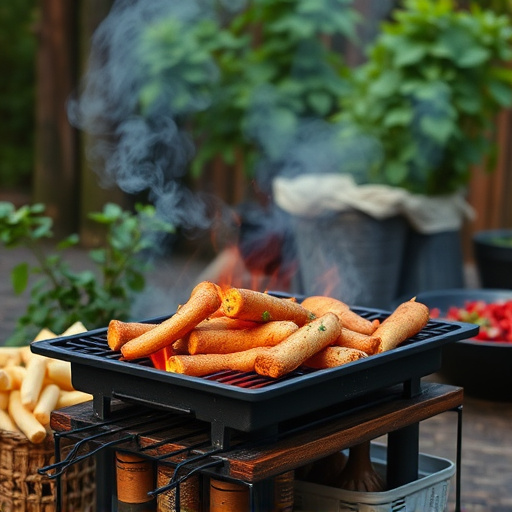Selecting high-quality, meaty ribs with visible marbling is crucial for an exceptional Beef BBQ Ribs Recipe. Mastering a flavorful dry rub seasoning blend of paprika, garlic powder, salt, and pepper enhances taste and locks in moisture during low-and-slow grilling at 225°F to 300°F (107°C to 149°C). Regular rubs or mopping with sauces keep ribs moist. Optimal temperature control prevents overcooking by breaking down collagen, resulting in tender, juicy ribs that pair well with BBQ sauce glazes for added flavor.
Unleash your inner barbecue master with the ultimate guide to grilling perfect beef ribs. From selecting the ideal cuts, like Kansas City or Memphis-style ribs, to mastering dry rub seasoning and smoking techniques, we’ve got you covered. Learn the secrets to temperature control, ensuring each rib is cooked evenly for maximum tenderness. Discover sauces and glazes to elevate your beef BBQ ribs recipe to a whole new level. Get ready to impress with every bite.
- Selecting the Perfect Ribs: Choosing Your Beef Cuts
- Dry Rub Seasoning: Creating a Flavorful Base
- Smoking Technique: Mastering the BBQ Art
- Temperature Control: Ensuring Even Cooking
- Slow and Steady: The Key to Tender Ribs
- Sauces and Glazes: Adding That Extra Kick
Selecting the Perfect Ribs: Choosing Your Beef Cuts
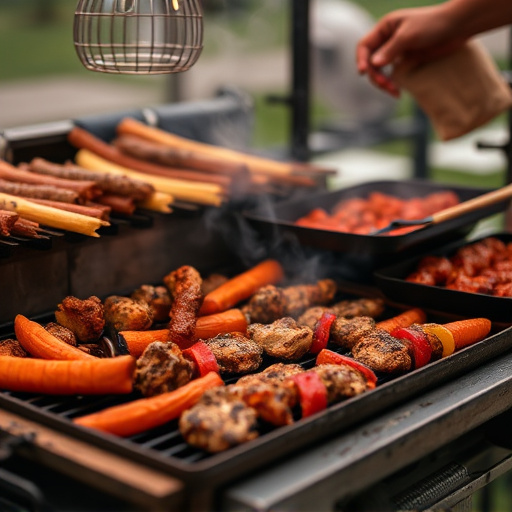
When it comes to grilling perfect beef BBQ ribs, selecting the right cut is half the battle won. Look for meaty ribs with plenty of marbling; this fat will render during cooking, adding flavor and keeping your ribs tender. The most popular choice for a reason, baby back ribs are an excellent option due to their balance between meat and bone. For a heartier meal, consider St. Louis-style ribs, known for their thin membrane that can be easily peeled away after cooking. Regardless of the style, aim for high-quality, well-marbled beef cuts for the best results in your BBQ rib recipe.
Choosing the right ribs is crucial for achieving that mouthwatering, slow-cooked flavor. Look out for cuts with a good balance of meat to bone, ensuring they’ll hold up well on the grill and provide a satisfying chew. Whether you’re a fan of baby back or St. Louis-style, selecting premium beef BBQ ribs will elevate your grilling game, leaving your taste buds craving for more.
Dry Rub Seasoning: Creating a Flavorful Base
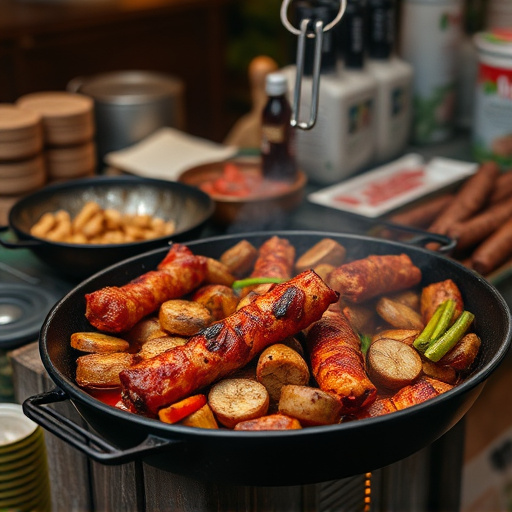
When it comes to grilling perfect beef BBQ ribs, Dry Rub Seasoning is where it all begins. This flavorful base is a crucial step in achieving that mouthwatering, smoky taste that rib lovers crave. A good dry rub recipe should include a blend of spices like paprika, garlic powder, salt, and pepper, creating a complex flavor profile that enhances the natural meat juices.
Creating your own Dry Rub allows for customization to suit personal preferences. Experiment with different spice ratios and even add unique ingredients like brown sugar or chili powder to make it your own. This base seasoning not only adds depth but also helps in sealing in moisture during the grilling process, ensuring tender and juicy ribs every time.
Smoking Technique: Mastering the BBQ Art
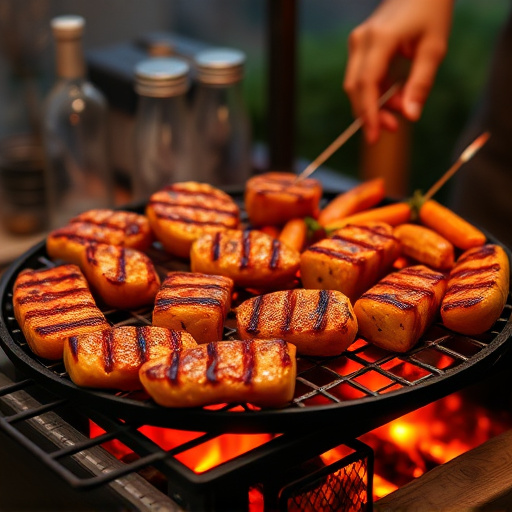
Smoking beef ribs is an art that requires precision and patience, making it a favorite among BBQ enthusiasts. The key to achieving tender, mouthwatering results lies in understanding the smoking technique. This process involves more than just firing up the grill; it’s about creating an environment where slow cooking meets intense flavor infusion.
The ideal method is low and slow—a strategy that allows the ribs to cook for extended periods at a temperature range of 225°F to 300°F (107°C to 150°C). This gentle approach ensures the meat becomes tender, almost falling off the bone. During the smoking process, the ribs are gently rubbed with a spice mix or mopped with a sauce, enhancing their flavor and preventing dryness. The smoke from burning wood chips imparts a subtle, delicious taste, making it an indispensable element in crafting the perfect beef BBQ ribs recipe.
Temperature Control: Ensuring Even Cooking
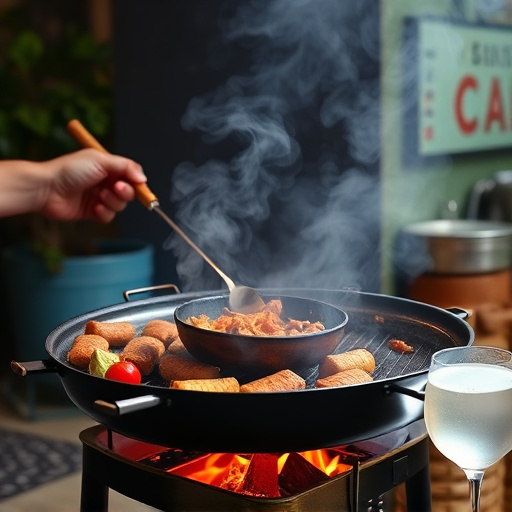
Maintaining proper temperature control is essential for achieving perfectly grilled beef BBQ ribs. The ideal cooking range for ribs is between 225°F to 300°F (107°C to 149°C). This slow and steady cooking process allows the collagen in the meat to break down, making the ribs tender and juicy. Using a reliable grill thermometer helps you keep an eye on the temperature, ensuring even cooking throughout. Avoid high heat as it can cause the exterior to burn before the interior is cooked sufficiently.
For best results with your beef BBQ rib recipe, consider using indirect heat methods like the “225°F (107°C) Rule.” This involves placing the ribs on one side of the grill and using the other side for heating indirectly. This technique promotes slow, even cooking, resulting in delicious, falling-off-the-bone ribs. Regularly checking the temperature and adjusting your heat sources accordingly will ensure your ribs are cooked to perfection every time.
Slow and Steady: The Key to Tender Ribs

When it comes to grilling perfect beef BBQ ribs, patience is a virtue. Cooking ribs slowly and steadily is the key to achieving that coveted tender texture. This method allows the collagen in the meat to break down gradually, resulting in juicy, fall-off-the-bone ribs. Many novice grillers make the mistake of rushing the process, but a slower approach ensures even cooking and prevents overcooking, which can dry out the ribs.
The ideal temperature for grilling ribs is between 225°F to 250°F (approximately 107°C to 121°C). This low-and-slow technique is essential for retaining moisture and flavor. By cooking ribs at a steady, moderate heat, you can enjoy the subtle transformation of tough rib meat into tender, delicious treats that glisten with mouthwatering BBQ sauce.
Sauces and Glazes: Adding That Extra Kick
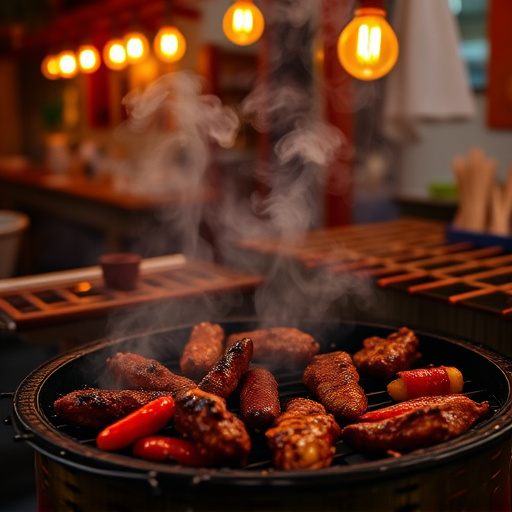
Adding sauces and glazes to your beef BBQ ribs recipe is a simple yet effective way to enhance flavor and create a mouthwatering finish. These condiments not only moisturize the meat but also add depth and complexity to the overall taste experience. When selecting a sauce, consider balancing sweet, tangy, and smoky elements for a harmonious blend that complements the rich, tender beef.
Experiment with different types of sauces—from classic ketchup-based options to more exotic blends featuring chili pepper, brown sugar, or even fruit juices—to find your favorite. Glazes, on the other hand, offer a thick, glossy finish that seals in juices and adds an extra layer of flavor. Apply glazes liberally during the last 15-20 minutes of cooking for a shiny, delectable crust that will have everyone begging for more.
